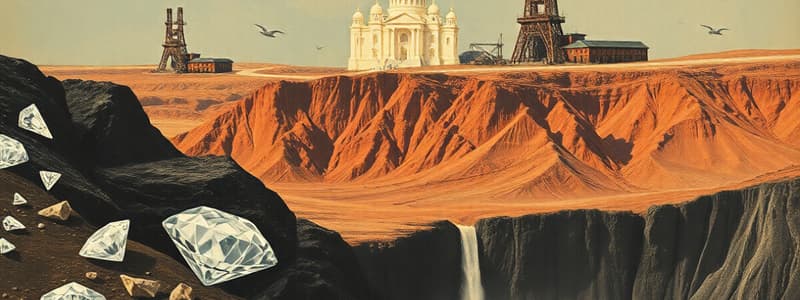Podcast
Questions and Answers
Which method involves analyzing the chemical composition of samples when indicator minerals are not located?
Which method involves analyzing the chemical composition of samples when indicator minerals are not located?
- Character Sampling
- Microdiamond testing
- Seismic surveys
- Geochemical testing (correct)
What is the purpose of the microdiamond testing stage in diamond recovery?
What is the purpose of the microdiamond testing stage in diamond recovery?
- To determine the overall size of the deposit
- To evaluate the clarity and color of diamonds
- To perform geochemical analysis of soils
- To find tiny diamonds in extracted samples (correct)
Which sampling method provides information about diamond size, shape, clarity, and color based on processing a large quantity of earth?
Which sampling method provides information about diamond size, shape, clarity, and color based on processing a large quantity of earth?
- Bulk Sampling
- Core Sampling
- Geochemical Sampling
- Character Sampling (correct)
What is assessed during the character sampling phase in the diamond recovery process?
What is assessed during the character sampling phase in the diamond recovery process?
What is indicated when indicator minerals such as garnet or chromite are found during exploration?
What is indicated when indicator minerals such as garnet or chromite are found during exploration?
Which method is commonly used for modern exploration of alluvial deposits?
Which method is commonly used for modern exploration of alluvial deposits?
What is the primary characteristic of secondary diamond deposits?
What is the primary characteristic of secondary diamond deposits?
Which of these statements best describes the location of most diamond-bearing kimberlites?
Which of these statements best describes the location of most diamond-bearing kimberlites?
What is the significance of cratons in diamond exploration?
What is the significance of cratons in diamond exploration?
What technique involves analyzing soil for evidence of diamonds in exploration?
What technique involves analyzing soil for evidence of diamonds in exploration?
What typically happens to heavily included diamonds during the secondary deposition process?
What typically happens to heavily included diamonds during the secondary deposition process?
What is a significant factor that influences the strength of river currents in the secondary deposition of diamonds?
What is a significant factor that influences the strength of river currents in the secondary deposition of diamonds?
What is the estimated time frame to go from diamond exploration to the first mining of diamonds?
What is the estimated time frame to go from diamond exploration to the first mining of diamonds?
What is the primary purpose of the sizing step in diamond recovery?
What is the primary purpose of the sizing step in diamond recovery?
Which recovery method utilizes the property of diamonds to stick to grease?
Which recovery method utilizes the property of diamonds to stick to grease?
In diamond mining, what is the significance of X-ray separation?
In diamond mining, what is the significance of X-ray separation?
What distinguishes onshore marine mining from other mining methods?
What distinguishes onshore marine mining from other mining methods?
Why has there been a shift from alluvial to primary deposits in diamond mining?
Why has there been a shift from alluvial to primary deposits in diamond mining?
What is the primary mining method used in cave mining for diamonds?
What is the primary mining method used in cave mining for diamonds?
What is a notable characteristic of alluvial mining in terms of diamond production?
What is a notable characteristic of alluvial mining in terms of diamond production?
How does marine mining differ from traditional land mining methods?
How does marine mining differ from traditional land mining methods?
What is the initial action taken when starting an open-pit mining operation?
What is the initial action taken when starting an open-pit mining operation?
What is the primary purpose of horizontal tunnels in an underground mine?
What is the primary purpose of horizontal tunnels in an underground mine?
What type of charge is typically used to blast ore in open-pit mining to minimize damage to diamonds?
What type of charge is typically used to blast ore in open-pit mining to minimize damage to diamonds?
How do the characteristics of an open-pit mine change as it deepens?
How do the characteristics of an open-pit mine change as it deepens?
What method is employed to create access for mining in an underground operation?
What method is employed to create access for mining in an underground operation?
What is one method used in diamond exploration that involves the use of sound waves?
What is one method used in diamond exploration that involves the use of sound waves?
What is the main purpose of character sampling in diamond exploration?
What is the main purpose of character sampling in diamond exploration?
Which method is commonly used to look for tiny diamonds in a rock sample?
Which method is commonly used to look for tiny diamonds in a rock sample?
What type of surveys are widely used in diamond exploration to detect variations in magnetic response?
What type of surveys are widely used in diamond exploration to detect variations in magnetic response?
Which indicator mineral is NOT commonly associated with kimberlite or lamproite?
Which indicator mineral is NOT commonly associated with kimberlite or lamproite?
What is the primary process used in cave mining for removing ore?
What is the primary process used in cave mining for removing ore?
What is the role of the cyclone in the Dense Media Separation process?
What is the role of the cyclone in the Dense Media Separation process?
How does the grease belt method assist in diamond recovery?
How does the grease belt method assist in diamond recovery?
Which factor primarily differentiates alluvial mining from primary deposit mining?
Which factor primarily differentiates alluvial mining from primary deposit mining?
What is a significant challenge of large-scale alluvial mining for larger companies?
What is a significant challenge of large-scale alluvial mining for larger companies?
What technique is most commonly used for marine mining operations?
What technique is most commonly used for marine mining operations?
What is the main advantage of using modified alluvial mining methods?
What is the main advantage of using modified alluvial mining methods?
What is the primary mining technique used to extract diamonds from underground deposits?
What is the primary mining technique used to extract diamonds from underground deposits?
What type of rocks are primarily associated with diamond formation?
What type of rocks are primarily associated with diamond formation?
What is the most common source of blue color in diamonds?
What is the most common source of blue color in diamonds?
Which of the following igneous rocks is much more commonly associated with diamonds?
Which of the following igneous rocks is much more commonly associated with diamonds?
What is the primary condition needed for diamonds to form in mantle keels?
What is the primary condition needed for diamonds to form in mantle keels?
How were diamonds primarily delivered to the Earth's surface?
How were diamonds primarily delivered to the Earth's surface?
What characterizes carbonado diamonds?
What characterizes carbonado diamonds?
Which layer of the Earth is referred to as the 'crust'?
Which layer of the Earth is referred to as the 'crust'?
What is the primary geological process that brings diamonds to the surface?
What is the primary geological process that brings diamonds to the surface?
What term describes the large, ancient, stable parts of Earth's landmasses?
What term describes the large, ancient, stable parts of Earth's landmasses?
Which of the following statements distinguishes metamorphic rock?
Which of the following statements distinguishes metamorphic rock?
What is a key factor in the formation of most diamond deposits?
What is a key factor in the formation of most diamond deposits?
What best defines the geothermal gradient?
What best defines the geothermal gradient?
What is the primary component of carbonate compounds?
What is the primary component of carbonate compounds?
Flashcards
Gravity Surveys
Gravity Surveys
Measure density variations in the ground to find kimberlite or lamproite, indicating diamond deposits.
Magnetic Surveys
Magnetic Surveys
Measure variations in magnetic response to find kimberlite. A unique fingerprint helps pinpoint diamond-bearing rocks.
Electromagnetic Surveys
Electromagnetic Surveys
Use energy waves to find underground rock features helping locate diamond deposits.
Seismic Surveys
Seismic Surveys
Signup and view all the flashcards
Indicator Minerals
Indicator Minerals
Signup and view all the flashcards
Geochemical Testing
Geochemical Testing
Signup and view all the flashcards
Microdiamond Testing
Microdiamond Testing
Signup and view all the flashcards
Character Sampling
Character Sampling
Signup and view all the flashcards
Ore Grade
Ore Grade
Signup and view all the flashcards
Cave Mining
Cave Mining
Signup and view all the flashcards
Diamond Recovery - Sizing Step
Diamond Recovery - Sizing Step
Signup and view all the flashcards
Dense Media Separation
Dense Media Separation
Signup and view all the flashcards
Grease Belt Separation
Grease Belt Separation
Signup and view all the flashcards
X-ray Separation
X-ray Separation
Signup and view all the flashcards
Alluvial Mining
Alluvial Mining
Signup and view all the flashcards
Marine Mining
Marine Mining
Signup and view all the flashcards
Primary Diamond Deposits
Primary Diamond Deposits
Signup and view all the flashcards
Secondary Diamond Deposits
Secondary Diamond Deposits
Signup and view all the flashcards
Alluvial Deposits
Alluvial Deposits
Signup and view all the flashcards
Marine Deposits
Marine Deposits
Signup and view all the flashcards
Diamond Exploration Time
Diamond Exploration Time
Signup and view all the flashcards
Diamondiferous Deposits
Diamondiferous Deposits
Signup and view all the flashcards
Clifford's Rule
Clifford's Rule
Signup and view all the flashcards
Cratons
Cratons
Signup and view all the flashcards
Sound Wave Exploration
Sound Wave Exploration
Signup and view all the flashcards
Modern Alluvial Exploration
Modern Alluvial Exploration
Signup and view all the flashcards
Cave Mining
Cave Mining
Signup and view all the flashcards
Diamond Recovery - Sizing
Diamond Recovery - Sizing
Signup and view all the flashcards
Dense Media Separation
Dense Media Separation
Signup and view all the flashcards
Grease Belt Separation
Grease Belt Separation
Signup and view all the flashcards
X-ray Separation
X-ray Separation
Signup and view all the flashcards
Alluvial Mining (Secondary)
Alluvial Mining (Secondary)
Signup and view all the flashcards
Marine Mining
Marine Mining
Signup and view all the flashcards
Bulk Sample Size (Primary)
Bulk Sample Size (Primary)
Signup and view all the flashcards
Bulk Sample Size (Secondary)
Bulk Sample Size (Secondary)
Signup and view all the flashcards
Primary Deposit Mining Approach
Primary Deposit Mining Approach
Signup and view all the flashcards
Open-Pit Mining
Open-Pit Mining
Signup and view all the flashcards
Overburden
Overburden
Signup and view all the flashcards
Blue Ground
Blue Ground
Signup and view all the flashcards
Underground Mining
Underground Mining
Signup and view all the flashcards
Gravity Surveys
Gravity Surveys
Signup and view all the flashcards
Magnetic Surveys
Magnetic Surveys
Signup and view all the flashcards
Electromagnetic Surveys
Electromagnetic Surveys
Signup and view all the flashcards
Seismic Surveys
Seismic Surveys
Signup and view all the flashcards
Indicator Minerals
Indicator Minerals
Signup and view all the flashcards
Geochemical Testing
Geochemical Testing
Signup and view all the flashcards
Microdiamond Testing
Microdiamond Testing
Signup and view all the flashcards
Character Sampling
Character Sampling
Signup and view all the flashcards
Ore Grade
Ore Grade
Signup and view all the flashcards
Primary Diamond Deposits
Primary Diamond Deposits
Signup and view all the flashcards
Secondary Diamond Deposits
Secondary Diamond Deposits
Signup and view all the flashcards
Carbonado
Carbonado
Signup and view all the flashcards
Diamond Formation Rocks
Diamond Formation Rocks
Signup and view all the flashcards
Carbonate
Carbonate
Signup and view all the flashcards
CLIPPIR Diamonds
CLIPPIR Diamonds
Signup and view all the flashcards
Diamond Formation Conditions
Diamond Formation Conditions
Signup and view all the flashcards
Core (Earth)
Core (Earth)
Signup and view all the flashcards
Mantle Keels & Cratons
Mantle Keels & Cratons
Signup and view all the flashcards
Types of Mined Diamonds
Types of Mined Diamonds
Signup and view all the flashcards
Cratons
Cratons
Signup and view all the flashcards
Superdeep Diamonds
Superdeep Diamonds
Signup and view all the flashcards
Crust (Earth)
Crust (Earth)
Signup and view all the flashcards
Crustal Diamond
Crustal Diamond
Signup and view all the flashcards
Carbon Availability
Carbon Availability
Signup and view all the flashcards
Eruption (Geological)
Eruption (Geological)
Signup and view all the flashcards
Diamond Formation Clues
Diamond Formation Clues
Signup and view all the flashcards
Geothermal Gradient
Geothermal Gradient
Signup and view all the flashcards
CLIPPIR Diamonds
CLIPPIR Diamonds
Signup and view all the flashcards
Igneous Rock
Igneous Rock
Signup and view all the flashcards
Blue Diamond Color
Blue Diamond Color
Signup and view all the flashcards
Lithosphere
Lithosphere
Signup and view all the flashcards
Boron Origin
Boron Origin
Signup and view all the flashcards
Carbonado Diamond
Carbonado Diamond
Signup and view all the flashcards
Magma
Magma
Signup and view all the flashcards
Diamond Surface Delivery
Diamond Surface Delivery
Signup and view all the flashcards
Mantle (Earth)
Mantle (Earth)
Signup and view all the flashcards
Diamond Transportation Rocks
Diamond Transportation Rocks
Signup and view all the flashcards
Mantle Keels
Mantle Keels
Signup and view all the flashcards
Kimberlite vs Lamproite
Kimberlite vs Lamproite
Signup and view all the flashcards
Metamorphic Rock
Metamorphic Rock
Signup and view all the flashcards
Metasomatism
Metasomatism
Signup and view all the flashcards
Pipe Deposits
Pipe Deposits
Signup and view all the flashcards
Economic Diamond Deposits
Economic Diamond Deposits
Signup and view all the flashcards
Mineral
Mineral
Signup and view all the flashcards
Pipe (Geological)
Pipe (Geological)
Signup and view all the flashcards
Plate Tectonics
Plate Tectonics
Signup and view all the flashcards
Rocks
Rocks
Signup and view all the flashcards
Subduction
Subduction
Signup and view all the flashcards
Superdeep Diamonds
Superdeep Diamonds
Signup and view all the flashcards
Transition Zone (Earth)
Transition Zone (Earth)
Signup and view all the flashcards
Study Notes
Diamond Exploration & Mining
- Primary Deposits: Diamonds found in kimberlite or lamproite pipes that brought them to the surface.
- Secondary Deposits: Diamonds found outside pipes, often in alluvial (river) or marine deposits. Secondary deposits are typically richer in higher-quality diamonds due to erosion.
- Diamond Exploration Process: Takes over 10 years, beginning with searching for deposits and culminating in mining. Clifford's rule notes that kimberlites occur on cratons. Scientists now look at areas around cratons, too. Sound waves were initially used to locate diamond deposits based on how density affects wave speed. This was superseded by other methods like gravity surveys (variations in ground density to locate pipes), magnetic & electromagnetic surveys (sending/detecting energy waves to map underground rock formations) and seismic surveys (similar to magnetic and electromagnetic surveys, but using sound waves).
- Locating Deposits: Indicator minerals like garnet, spinel, diopside, olivine, ilmenite, chromite, & perovskite can signal nearby kimberlite or lamproite pipes. Geochemical testing of rock, soil or vegetation is also used, for example examining chemical composition.
- Testing Deposit Viability: Samples are taken to test for the presence and type of diamonds, size, shape, clarity and color. Microdiamond testing analyzes cores from primary deposits or from sediments for secondary deposits. Character sampling assesses 500 tons of earth to determine ore grade (diamond concentration per 100 tons of rock). Bulk sampling of 5,000-10,000 tons is used for accurate evaluation.
- Primary Deposit Mining: Digging out materials around the pipe to get the diamonds.
- Open Pit Mining: Removing overburden (rock/soil) above the pipe, blasting the ore, and then excavating the remaining material.
- Underground Mining: Tunneling into and around the pipe to access the ore. Drifts are drilled to extract ore.
- Diamond Recovery: Ore is reduced in size for easier processing. Dense media separation is used to separate diamond-bearing ore from lighter waste materials. Grease belt and X-ray separation are other recovery methods that rely on different properties of diamonds vs the other minerals mixed in with the ore.
Major Diamond Sources
- Africa: Major producers, including Botswana with the Orapa and Jwaneng mines and Russia.
- Australia: Had major diamond production (Argyle), but production drastically decreased starting in 2020.
- Americas: Canada is an important producer with the Ekati and Diavik mines. The US has low economic significance in diamond mining.
- Eurasia: India was once a main producer, but Russia has taken a lead role.
Studying That Suits You
Use AI to generate personalized quizzes and flashcards to suit your learning preferences.




